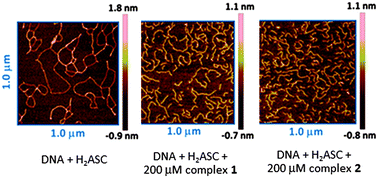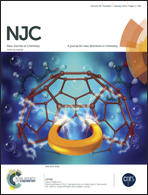DNA-interacting and biological properties of copper(ii) complexes from amidino-O-methylurea
Abstract
The interaction of two copper(II) complexes, namely [Cu(L1)Cl2]2 (1) and [Cu(L2)Cl2]2 (2), where L1 = 1-amidino-O-methylurea and L2 = N-(benzyl)-amidino-O-methylurea, with DNA has been thoroughly investigated using different characterization techniques, including electronic absorption spectroscopy, viscosity measurements, fluorescence spectroscopy, circular dichroism spectroscopy, thermal denaturation, stoichiometric determination, gel electrophoresis and atomic-force microscopy. The coordination compounds exhibit DNA binding potential by non-intercalation and DNA-cleaving ability through the oxidative pathway. Indeed, both complexes display antibacterial properties (against three bacteria involved in human-food poisoning, i.e. Salmonella, E. coli and Campylobacter). Furthermore, their cytotoxicity has been tested against three cancer cell lines, which are the small cell lung carcinoma (NCI-H187), the oral cavity carcinoma (KB) and the breast adenocarcinoma (MCF-7) and it was revealed that they are more cytotoxic than cisplatin against the NCI-H187 cancer cell line.


 Please wait while we load your content...
Please wait while we load your content...